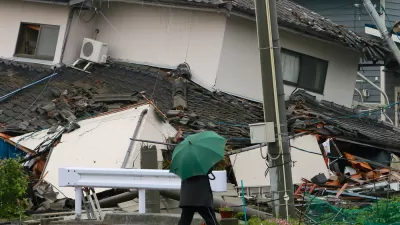Edwin Heathcote examines the common ethos that connects Kyoto's Katsura Imperial Villa and Los Angeles's Schindler House, "two homes, far apart in time and space, that influenced the modern movement."
Heathcote draws a line from Japan's traditional architecture, where "[w]alls are ephemeral – paper framed in slender wooden battens – and can be slid aside to disappear entirely and open up the rooms to the landscape or allow spaces to flow into each other," through Bruno Taut, Walter Gropius, Le Corbusier, and Austrian emigre Rudolf Schindler who were highly influenced by the conceptions of space, materiality, and history found in buildings like the Katsura Imperial Villa. "Coming from cities hidebound in history where architects were constrained by respect for the existing fabric and forced to build in streets laid out of medieval palimpsests," says Heathcote, "they were profoundly impressed by this building existing in a landscape and generated by its own internal geometry."
Of Schindler's house on Kings Road in West Hollywood, which Heathcote calls "arguably the first modernist house in the US," he says "[i]t is profoundly Japanese in character: dark timber posts and beams filled in with white panels recall the paper walls of the Katsura Villa."
"Like the Japanese model, the walls were sliding and spaces flowed into each other. There were no corridors and there was no fixed hierarchy of rooms; this was a house with a fluid plan that presaged the modernism of Mies van der Rohe while also looking back to Frank Lloyd Wright’s wonderfully expansive plans."
"Wright himself was hugely influenced by what he saw in Japan but Schindler managed to imbibe more than style or impression, he translated the deceptively simple complexity of Japanese architecture into an American model."
FULL STORY: Proportional perfection

Maui's Vacation Rental Debate Turns Ugly
Verbal attacks, misinformation campaigns and fistfights plague a high-stakes debate to convert thousands of vacation rentals into long-term housing.

Planetizen Federal Action Tracker
A weekly monitor of how Trump’s orders and actions are impacting planners and planning in America.

San Francisco Suspends Traffic Calming Amidst Record Deaths
Citing “a challenging fiscal landscape,” the city will cease the program on the heels of 42 traffic deaths, including 24 pedestrians.

Defunct Pittsburgh Power Plant to Become Residential Tower
A decommissioned steam heat plant will be redeveloped into almost 100 affordable housing units.

Trump Prompts Restructuring of Transportation Research Board in “Unprecedented Overreach”
The TRB has eliminated more than half of its committees including those focused on climate, equity, and cities.

Amtrak Rolls Out New Orleans to Alabama “Mardi Gras” Train
The new service will operate morning and evening departures between Mobile and New Orleans.
Urban Design for Planners 1: Software Tools
This six-course series explores essential urban design concepts using open source software and equips planners with the tools they need to participate fully in the urban design process.
Planning for Universal Design
Learn the tools for implementing Universal Design in planning regulations.
Heyer Gruel & Associates PA
JM Goldson LLC
Custer County Colorado
City of Camden Redevelopment Agency
City of Astoria
Transportation Research & Education Center (TREC) at Portland State University
Jefferson Parish Government
Camden Redevelopment Agency
City of Claremont



























